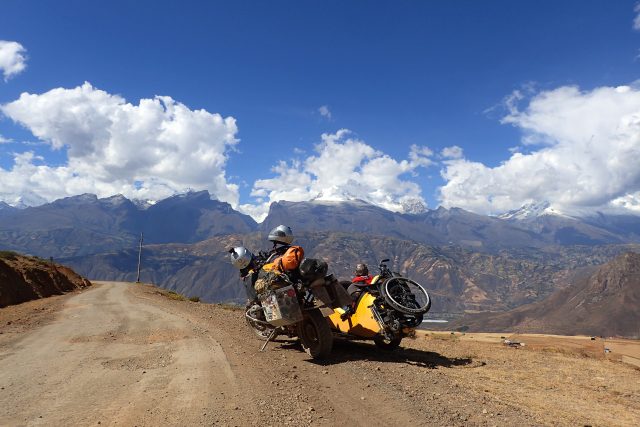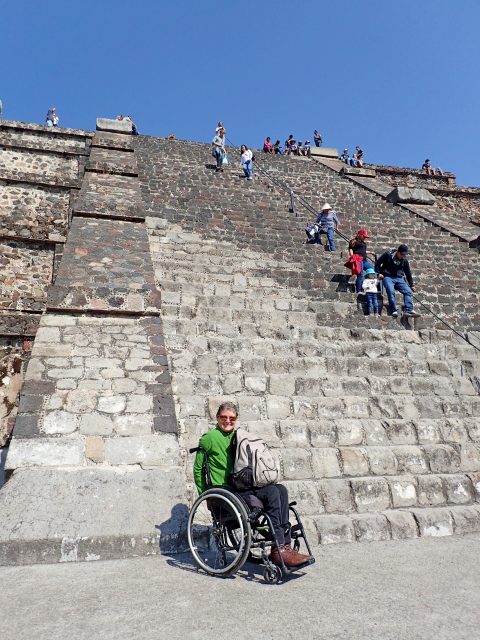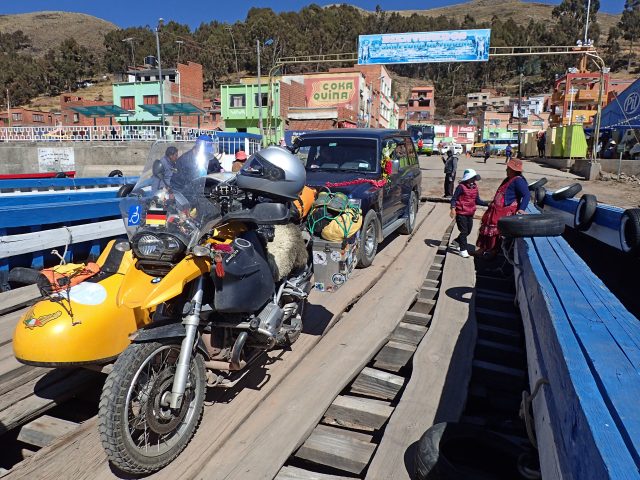Overland travel is an exciting, rewarding, and enriching experience for anyone, but when you are limited to using a wheelchair, this experience comes with its own unique set of challenges. Heike, wheelchair-bound since age 15, has learned to overcome these obstacles and faced her fears while traveling the Pan-American highway, Europe, and Southern Africa. Heike travels and has been traveling with her partner Toshi for the past six years with a motorcycle and sidecar, no less.

As you may imagine, traveling while restricted to a wheelchair requires a fair amount of planning, research, and preparation, significantly more so than when you are non-disabled. Tasks as simple as changing a tire become infinitely more challenging and can place you in a dangerous situation. The accessibility of the terrain also determines whether you can venture off-road, on the beach, or on muddy trails, as recovering your transport and yourself can sometimes be an impossible task. It stands to reason that ensuring that your mode of transportation is outfitted and designed to make your everyday tasks less tedious while offering you the freedom to explore is vital.

Indomitable Heike has used this experience to break down barriers and misconceptions about disability and promote greater understanding and acceptance. With a zest for life and Toshi’s constant love and care, Heike has proven that, with the proper preparation and mindset, nothing can hold you back from exploring the world, new places, and new cultures.

Tell us about yourselves.
Heike: I am a 59-year-old psychotherapist that specializes in PTSD and have been wheelchair-bound from the age of 15. I require a full-time personal assistant 24 hours a day to assist me with almost everything in my everyday life.
Toshi: I am 54 and have been working as Heike’s full-time assistant since I was 20 years old when I decided to take on the position to fund my studies while in University.


You have both been traveling since the 1990s; when did you decide that the overland lifestyle would be a large part of your future?
Heike: Toshi’s dream had always been to complete a circumnavigation on a sailboat, and so we experimented with it for a while and decided to purchase a (live-aboard) sailing catamaran; unfortunately, it did not suit our needs. However, this was the start of the travel bug.
Toshi: After experimenting with sailing, we decided that a motorbike with a sidecar may be a better choice as you can experience travel on a more personal level, but at that point in time, we didn’t want to venture off on a long-term basis. It was only after attending a Horizons Unlimited meetup that we were convinced that this was to be our lifestyle. And now, here we are, having done a thing many non-disabled people keep dreaming of all their lives.
What has surprised you both the most about overland travel?
Heike: The motorcycling community. The abundance of helping hands, invitations, support, and lasting friendships that come from it, is overwhelming. The second thing I realized is that I experienced nearly no discrimination. I felt accepted and seen as a person instead of a “wheelchair .”And this is not only in the community of motorcycle travel but also by most people in the countries we visited. The less “Western” the countries became, the more people opened up with questions about me and my disabilities. I liked the child-like curiosity instead of the Western-style avoidance of the topic.
What motivates and inspires you both to travel?
Heike: Definitely not sightseeing. We’re more the “meet people” kind of travelers. We speak to the locals to understand their mentality and culture. Now sprinkle in the odd “Wow!” landscape and excellent windy roads, and you have our dream voyage.

What is your philosophy of life and travel?
Toshi: Plans are only as good as your ability to dump them. Make the best of it, and you will be rewarded… Courage is not the absence of fear. If you only do things you don’t fear, there’s no need for courage. Or, you’re simply underestimating the situation and are about to get in trouble.
Heike: Where there’s a will, there is a way. The only borders are in your mind. I’m not a person with disabilities; people create disabilities. In other words: most obstacles I face are made by other people or authorities. I have never felt more physically whole and capable and less discriminated against before in my life than on our trip. But we have an agreement carved in stone: If one of us has a bad gut feeling, we get out of the place—no discussions!

In 2018, you both traveled down the Pan-American Highway and then toured Southern Africa in 2019. Which countries were your favorite overland destinations and why?
Toshi: One of the most significant advantages of traveling the Americas is this: you only need one language for most of the countries. Speaking Spanish makes all these places so much more accessible and fun.
Heike: We particularly liked Peru and Ecuador for the riding and landscapes, Mexico for the people we met, and Namibia for the wildlife. It’s always rather the [experiences] we had than the peculiarities of the countries we were in that made every single one memorable.

Which country was the most difficult to travel in or around with a sidecar?
Heike: It most probably would have been Namibia. But since the bike had broken down several times, we had a 4×4 Toyota Hilux truck, which I loved! We could even sleep on the flatbed. Wonderful! Just hide behind a hill by the road and rest for the night.
Toshi: On the other hand, you almost always have a choice to do it the harder or, the softer way. And we would have chosen different, better roads in Namibia with the bike, perhaps with the drawback of not seeing as much.
While traveling with a motorbike and sidecar, do you mostly camp or stay in accommodations?
Heike: We always carry a tent and use it frequently, but in Latin America, we mainly chose accommodations since they were cheap and easy to find. Plus, we were there in the colder half of the year, and general camping isn’t as common as elsewhere.

Do you travel with custom-made gear or equipment?
Toshi: Our sidecar setup, of course, has some tweaks and additions. Most of them are done by the manufacturer, Ralph Kalich, or ourselves.
Heike: The best thing we carry is my sidecar loo: A toilet seat that attaches to the back of the sidecar and allows me to follow my nature almost everywhere where there is a place to hide. And I have a “poncho” that covers me in the sidecar. Together with my electrically heated jacket, this makes for a cozy ride, even in wet and cold conditions.

What challenges do you face on a day-to-day basis?
Heike: For me, it’s toilets. Or the lack of accessible ones. If you don’t know when there will be a place to return your drinks, you don’t drink all day. Not a healthy choice, sometimes.
Toshi: Apart from that, it was often a gamble whether the accommodation we had aimed for would be accessible enough to get in, up the stairs, and around in our room and bathroom. Depending on where you are, this could mean another one or two hours of riding.
Heike: A fundamental thing we needed to maintain was Toshi’s health and fitness. I would be helpless if he couldn’t lift me, push my chair, or assist me with many other things. This certainly kept us from choosing the more dangerous roads or options more than just once. We never felt we were playing it too safe, though.

How have you been able to mitigate those challenges?
Heike: Stairs, as long as they’re straight, allow Toshi to pull me up backward in my wheelchair. Toshi is a strong man, and he’s quite skilled in carrying and handling me, with or without my chair. That way, we mostly get along even in tiny rooms.
Toshi: Improvising has become second nature for the two of us. Heike got used to the lack of accessibility, and I simply needed to keep healthy and strong. Both worked out well.
Heike: I would like to add three more aspects: We developed a mindset of tackling the challenges as they arose. We got good at wasting our time wisely instead of planning too far ahead and sticking to a schedule. Lastly, we accepted help when offered and asked for help if anyone was around.

How has traveling changed you, and do you have any travel dreams or goals?
Heike: We must rely on each other even more so than other travel companions, not only physically but also concerning communication. I need and can take almost any honest answer, and Toshi is the same. And even when we’re angry, one communication channel is always kept open, no matter what: the one concerning my assistance.
Toshi: We learned to swallow our pride much quicker than in everyday life. Because we needed to, this doesn’t mean we didn’t argue. We just did it a lot faster and with more focus on solutions than we’d typically do.
Heike: This is something we already established on past travels. It just got more intense and evident to us on extended trips.
I’m overly grateful for this experience. I experienced that all people are only out for love, happiness, and fulfilling our basic human needs. This connects us to any human being, so I feel more like a world citizen than one of a specific nation.


Are there any community resources that you rely on?
Heike: We try not to rely too much on others. We always tried to be as self-sufficient as possible. Nonetheless, we have many helpful contacts via Horizons Unlimited, Facebook, and motorcycle groups in Latin America, especially the WhatsApp groups “Planeando Rutas” and “Moto Ayuda Internacional.” Not to forget the personal contacts we had through the motorcycle community.
Toshi: One community-driven resource we used a lot is the iOverlander app. iOverlander can be tremendously helpful when looking for places to stay, be it camping or accommodation, and it contains much more information than that.
And we used map files based on the community-driven OpenStreetMap project for our Garmin navigator. They’re accessible, often more accurate, and sometimes richer in detail than commercial ones. It is a pity that the site that used to let you choose OSM tiles from the world map to create up-to-date Garmin map files has been shut down recently.

Do you have any advice for those who dream of living a life of adventure but feel that the challenges they may face are insurmountable?
Heike: We were frightened to death while preparing to leave. The tricky thing is, you know exactly what you lose because it’s all there, right in front of your eyes: your cozy home, your life, your possessions, everything you leave behind. Whatever you may gain by going on a big trip like this is completely unknown to you until it happens. Often the balance between the gains and losses tips firmly in favor of staying home.
Most people are not very good at expecting something better from change as long as they feel their life is still within a bearable range. And failure is a possibility. Be aware that there’s always a way out if you don’t like it or the challenges you encounter are too complicated. Give yourself the freedom to skip the rest of the trip and go home at any time. On the other hand, I learned that I am a lot tougher than I thought. And if I, a person without muscular control of my limbs, can make it through a trip like ours, why shouldn’t you?


Tell us about your motorbike and sidecar and what modifications have been made to your adventure gear and equipment.
Toshi: [Our bike is a] 2005 BMW R1200 GS with a leaner sidecar built by Ralph Kalich in Germany. Being a leaner means that, unlike most sidecar rigs, you still lean the bike into the turns. This is great on almost any road with a good grip. On slippery and uneven ground, especially on loose sand or gravel, the leaner can be pretty tricky. First, you must keep your eyes on both tracks. Second, adding quite a bit of spice to the riding experience, the sidecar can introduce some unexpected momentum into the bike. And third, the motorcycle of a leaner sidecar rig can fall over.
Heike: Before the trip, the suspension was raised, and the sidecar wheel diameter increased to improve offroad performance. I have an air seat cushion that gives me an extra bit of suspension, as the shock on the sidecar has only 6 cm of travel. The bike is also equipped with auxiliary fuel tanks, giving us a maximum range of more than 500 km.
Toshi: I like my (formerly white) sheepskin seat cover. It keeps you warm and cool since it doesn’t heat up in the sun and allows for a bit of airflow under your bottom.

Heike: My poncho, with a neoprene collar, keeps me warm and dry but also keeps the sun out when needed. Even freezing conditions are bearable with my heated jacket connected to the bike’s battery, even for a few hours.
A wheelchair rack on the back of the sidecar is essential, and even under heavy off-road conditions, the 14 kg wheelchair never came loose. One big plus: we can mount a toilet seat to the rack, which gives me an outdoor toilet almost anywhere within minutes.
How can people follow your adventures?
Heike: You can find our travel reports on our dedicated blog, awillandaway.de

Our No Compromise Clause: We carefully screen all contributors to ensure they are independent and impartial. We never have and never will accept advertorial, and we do not allow advertising to influence our product or destination reviews.


